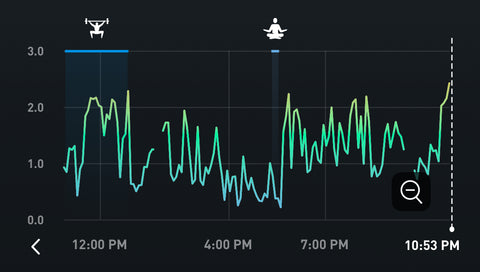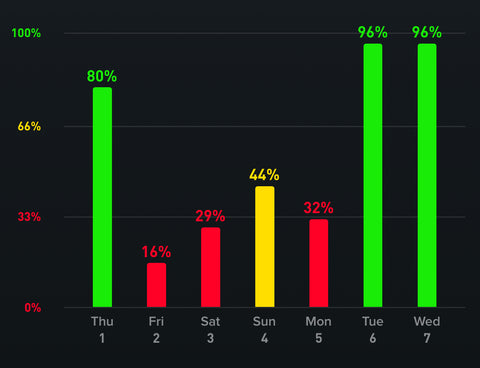When my older daughter started wearing a Whoop to track her training and recovery for her college ski team, I immediately developed Whoop envy. If you’re not familiar with the Whoop, it’s a wearable device that tracks data such as your resting heart rate, your sleep (light, deep, and REM), your heart rate variability, and your respiratory rate. It gives you several scores every day, including recovery, sleep, and stress. A green score is good, yellow is okay, and red is an indication that your body is working hard to recover but might need a minute.
This all sounded right up my alley. I love data, and especially data about my body, because it’s where I live. After studying the human body obsessively in medical school and having used numbers like heart rate and respiratory rate to inform my care of countless patients in the ER and the ICU, I was thrilled with the idea of being able to track my own body in a numerical way on a daily basis. So I signed up, and soon had the app installed and the little doodad on my wrist. And it was every bit as cool as I had hoped.
I’ve been wearing my Whoop for over a year now, and while it may not be a tool I use for the rest of my life, it’s taught me some super useful things about my body. While these learnings may not apply to every human body, I’m guessing many of them do. My Whoop revelations are not terribly shocking, but having the cold hard numbers in my face has helped me understand them as facts, rather than unproven theories. Here are the top seven things I have learned from wearing a Whoop.
Whoop Fact #1: Alcohol is bad for you
Let’s just get this one out of the way. I’m not going to bother sugar coating it: alcohol has some toxic effects on your body, in pretty much any quantity. Every time I have any alcohol, it shows up in the numbers. My sleep is not as good, my heart rate variability is lower (higher is better), and my recovery score is reduced the next day. This is especially true if I’ve also done a hard workout that day. As a medical doctor, I have long known that alcohol is not good for you, but seeing the exact physiological effect it has on my body has helped change my relationship with alcohol. I now take three or four nights a week away from alcohol, and usually stick to one serving on the nights I do drink. It’s so easy to slip into a nightly habit of one or two drinks, but after seeing the consequences of alcohol on my cardiovascular system, I simply can’t justify that level of consumption anymore. It doesn’t feel fair to the body that works so hard for me every day, especially since athletic endeavors are such an integral part of my life. I also have a strong family history of atrial fibrillation, and have dabbled in arrhythmia myself, so I’m doubly motivated to drink less than my fibrillating relatives do. (Alcohol has an almost linear relationship to atrial fibrillation.) In the screenshot below, I had consumed alcohol on Thursday, Friday, and Saturday nights, and my recovery scores the following days were either yellow or red.

Whoop Fact #2: If you’re going to drink, earlier is better
While I drink less regularly than I used do, I still have a few drinks a week. Even though it's not the biologically healthy choice, there is often a nice social element to sharing a drink with friends that I enjoy, and I take pride in crafting a pretty perfect cocktail! When I stop drinking by six or seven o’clock, and switch to water or electrolytes, the impact on my Whoop scores is substantially mitigated. I’ve even had a few occasions where I’ve had a cocktail or a beer early in the evening, and still managed to Whoop green the next day. If I have more than one drink, or if I drink anything after 7pm, green usually goes out the window. As I write, I’m still enjoying the gentle warmth of the (one) margarita I had at the airport bar before boarding an early evening flight to LA. We’ll see what it does to my numbers tomorrow!*
Whoop Fact #3: Hard cardio workouts are, um, hard
I grew up in the Jane Fonda era where you did all cardio all the time. Even if you lifted weights, which I did, you did an hour of cardio first. After wearing a Whoop for a year, I can see a very clear pattern: my recovery scores are lower the day after a hard cardio session. This means, not surprisingly, that my little heart muscle worked its ass off and appreciates some time to recover before the next hard cardio day. So I tend to alternate cardio and strength days now, which means I’m able to get a green recovery most of the time. On the occasions, like our annual family cross-country ski trip, when I want to do multiple hard cardio days in a row, I know that my choice will have a negative impact on my recovery, but it’s a price I’m willing to pay from time to time.
Whoop Fact #4: My body is capable of repairing itself
Not a newsflash, I know, but the first time I saw a super low recovery score in a gruesome shade of red on my app, I felt like I must have done permanent damage—kinda like when you get that one C in college and it tanks your GPA for two years? It turns out that it only takes one day of good hydration, nutrition, and rest to get your Whoop score back up to an A+! I think seeing those numbers shift so dramatically with a little TLC confirms for me that when we care for our bodies, they care for us right back. Lucky for us, our bodies don’t hold much of a grudge as long as we don’t abuse them too often.
Whoop Fact #5: Good sleep is amazing, but bad sleep isn’t as bad as you think
You know those nights where you think you’re up all night, tossing and turning, tending to a kid or a dog, worrying about work, or simply flopping around in existential angst? On nights like that, I’m often surprised to see that I still somehow managed to get 70-80% of the sleep my body needed, and that’s not so bad! While nothing makes me happier than a sleep score of 100, I have been reassured to see that even on nights I would describe as horrible, I’ve been able to snatch some meaningful ZZZZs. In case it helps, here are my top ten tips for better sleep.
Whoop Fact #6: Meditation is not woowoo bullshit
I already knew this, based on the massive body of medical evidence demonstrating the myriad benefits of meditation, but it’s still cool to see it on my Whoop! Whoop introduced a Stress Monitor feature last year, where you can see your stress level bounce around in real time throughout the day. Stress goes up when you exercise, or when you’re hustling to get things done around the house, or when you step in dog poop on your way to the car when you’re carrying sixty-four things and running late for a meeting. And stress goes down when you meditate. Like, it plummets. My ten or twenty minutes of meditation are the lowest stress minutes of my day, every single day, without exception. Nothing reinforces a good habit for me more than raw biological data. So on days when I don’t feel like meditating, I sit down and get the job done because I know my body will appreciate it, even if my mind stays in the monkey zone. Here's how I got started meditating—it's not as hard as you think.

Whoop Fact #7: My menstrual cycle affects my recovery, without fail
Well, gentlemen, all I can say is Whoop, there it is. The numbers don't lie. The days before our periods are physiologically different. Now, even before the cramps start, I can tell that the red tide is coming, because my numbers are trash. And while I’m not training at a level where I necessarily adjust my workout based on my cycle, I have found that seeing the numbers has made me a little more gentle with myself when I’m feeling off in the days preceding my cycle. My recovery takes a hit about 3-4 days before my period, and tends to rebound quickly once I start bleeding, but I’m sure this pattern varies among women. In the screenshot below, I started my period on the 6th of the month.

I’ll finish this post with the question everyone will ask: should I get a Whoop or an Oura ring?? And I have not worn an Oura, so I’m not perfectly qualified to answer this question, but here’s what I’ve gleaned from talking to the Oura people in my life.
- Oura may be a smidge better for cycle tracking and fertility planning.
- Whoop may be a smidge better for tracking athletic performance and recovery.
- You can charge the Whoop while wearing it, but have to remove the Oura to charge it.
- If wearing a ring while you sleep annoys you, get the Whoop. If wearing a watch while you sleep annoys you, get the Oura.
- And in case you’re wondering, the Apple watch is an okay option for tracking your data, but not as good as either the Whoop or the Oura.
Hope this helps you decide whether a device like a Whoop would be useful to you in living your healthiest, happiest life. If you have any questions, send me a DM on Instagram!
* I whooped yellow the next day, with a 50% recovery and an HRV of 53. One drink and a night in a rather horrifying motel room with a 78% sleep score showed up in the numbers.